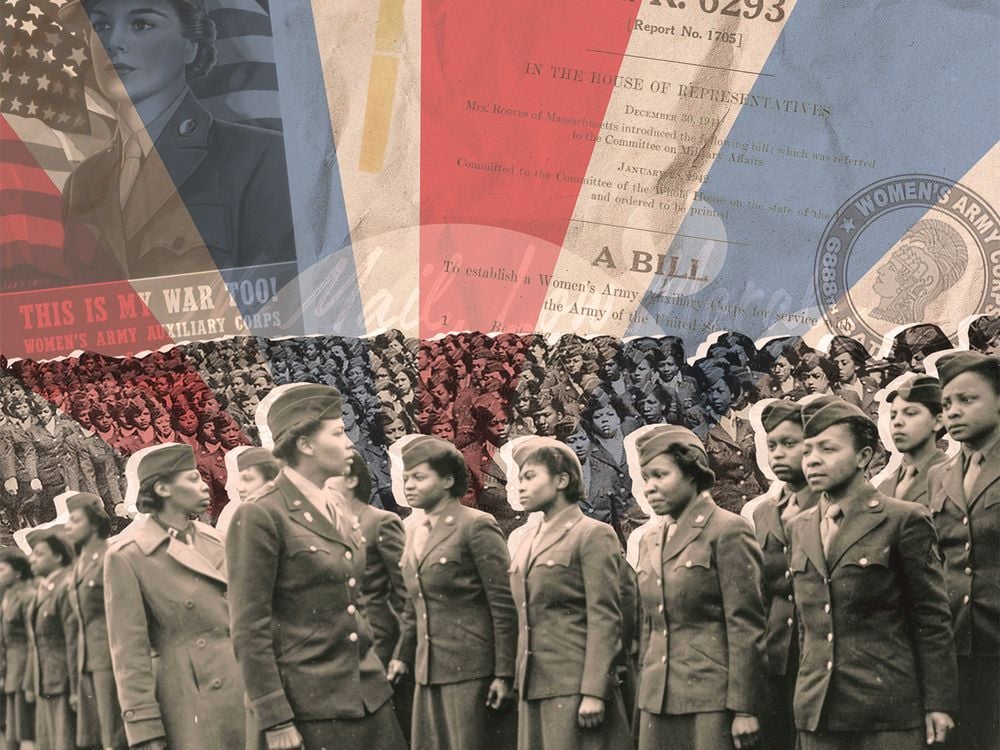
Colonel Edna Cummings had already been retired from the U.S. Army for more than a decade when she became aware of a distinguished World War II veteran with whom she shared a name: Lieutenant Colonel Charity Edna Adams. Adams had died in 2002, a year before Cummings’ retirement, but Cummings became fascinated with her story—and with that of the 6888th Central Postal Directory Battalion, the unit Adams had commanded.
It was the only unit composed entirely of Black women to have been deployed overseas during the war, and it had served a critical function: clearing the backlog of mail that marked the only line of communication between American soldiers in Europe and their loved ones back home.
The officers and enlisted women of the Six Triple Eight had been given a difficult mission, and they’d succeeded. But Cummings had served an entire career as an Army officer without ever having heard their story. She made it her business to help the women of the battalion—some of whom are still with us—get their much-belated due.
On our latest episode of the Smithsonian magazine podcast “There’s More to That,” I speak with Cummings and with Smithsonian magazine senior writer Jennie Rothenberg Gritz, who wrote about the Six Triple Eight for our March 2023 issue, about the long road to getting the women of the battalion their proper recognition—including a Congressional Gold Medal awarded in 2022, almost eight decades after their deployment.
A transcript is below. To subscribe to “There’s More to That,” and to listen to past episodes on J. Robert Oppenheimer, the vanishing Colorado River, and Barbie, find us on Apple Podcasts, Spotify or wherever you get your podcasts.
Chris Klimek: Earlier this year, a fresh chapter in American history began. New names started to appear on nine U.S. Army bases that previously honored Confederate soldiers. One facility in Virginia, known as Fort Lee, was renamed Fort Gregg-Adams. Retired Army Colonel Edna Cummings was at the dedication ceremony.
Colonel Edna Cummings: The significance of renaming Fort Lee to Fort Gregg-Adams, I am still unpacking that. Because I attended the event, and, when I saw it happen, it was one of those quiet moments.
Klimek: Fort Lee was named after Robert E. Lee, the head of the Confederate Army during the Civil War. Now it bears the names of two Black military officers.
Cummings: Just that alone, to replace one of the premier symbols of the Confederacy with two African Americans who contributed so much, we are still learning the impacts. I think it just is a reminder of pride, resilience and leadership, and a new set of role models that young people can embrace and look up to.
Klimek: The Gregg in Fort Gregg-Adams is Lieutenant General Arthur J. Gregg, who in 1977 became the first Black Army officer to achieve that high rank. Colonel Cummings got to meet him early in her own military career.
Cummings: He was one of my heroes, and I didn’t talk to generals that much. But he’s a legend because he entered the military at a time post-World War II and was tasked with desegregating Fort Lee.
Klimek: The Adams in Fort Gregg-Adams is Lieutenant Colonel Charity Edna Adams. Although Colonel Cummings never got to meet her in person, learning about her life sent Colonel Cummings down a path that changed everything.
From Smithsonian magazine and PRX Productions, this is “There’s More to That,” the show where we honor the trailblazers of the past who impact our lives today. In this episode, Colonel Cummings and Smithsonian magazine journalist Jennie Rothenberg Gritz introduce us to the Six Triple Eight. This was the only World War II battalion exclusively made up of women of color. We’ll also hear from some of the Six Triple Eight’s living members. I’m Chris Klimek. Let’s get started.
Cummings: Chris, I have a mission for you.
Chris Klimek: The Six Triple Eight was sent overseas to untangle the tremendous backlog of mail waiting to be opened by U.S. service people stationed abroad during World War II. This was the only line of communication for Army members to family and friends back home in America. I thought this sounded like a difficult but not unfamiliar task at first, and then Colonel Cummings made me imagine what it must have been like.
Cummings: I want you to go to this war-torn country. The war isn’t over. About 17, 18 million pieces of mail in packages rotting in a warehouse. You are the only one who I’m relying on to get it done. We’ve been at this for about five years now, and it’s getting worse. If you do not succeed, you’re going to get fired. I don’t have any resources other than what you’ve given me. You’re not going to give me a lot of support. Not only do I have to sort through the mail, I have to take care of 855 people and make sure they’re motivated. Then you throw in all these other elements.
Klimek: Unlike the kinds of World War II combat stories that get celebrated in movies, the Six Triple Eight’s mission was mostly logistical, but that didn’t make it any less important or any less difficult. The women of the Six Triple Eight got it done. But in the decades since, they were never properly recognized for their service. Colonel Cummings has made it her mission to change that.
Cummings: It’s important that we recognize this particular unit because I personally believe that the history was omitted. Everything that I ever saw about World War II, first of all, you didn’t see a lot of women. It was more of a passive and a footnote. None of the movies, conversations. Maybe we heard or I heard about a few Red Cross workers, nurses, but nothing about women who were in operational mode in supporting the war, meaning doing logistics, administrative support or even in theater. These women of any race were never depicted other than the object of a love interest of a male who was in the war. Then, digging deeper, learning that there were actually more than 7,000 Black women on active duty during World War II, including nurses in a group of these Black women, Red Cross workers, nurses, and this large contingent of women, the Six Triple Eight actually served overseas. That really heightened my interest.
Klimek: Colonel Cummings retired from active duty in 2003. Today her main focus is bringing attention to the Six Triple Eight. In fact, when we spoke with her, she had just gotten back from a tour of sites in Europe where the Six Triple Eight had served. Her tour group included some of the relatives of women from the unit. We started a conversation with Colonel Cummings by asking her how she first heard about this story.
Cummings: I first became aware of the Six Triple Eight as history just by happenstance. This was probably mid-2015, ’16. I was online, and something popped up in my feed about this Black colonel named Edna who spoke her mind and sometimes got in trouble for it. Her name was Charity Edna Adams. I connected to the story because strictly vanity reasons. I’m like, “Oh, somebody else named Edna who said things while she was in uniform and sometimes regretted it.” But then as I started to dig deeper, I became fascinated by the story.
Klimek: You served an entire career in the military without having heard of this woman prior to that, which definitely illustrates the fact that this is someone who has not been celebrated, memorialized in a way that would be appropriate.
Cummings: Exactly. Also, learning about Charity Adams caused me to dig deeper about the context of World War II. I now know more about World War II and military history than I did when I was on active duty. Maybe because I have more time to do the deep dive or pay attention. But I think it puts it in context. If it was included in terms of a conversation or curriculum for military history, I believe people would pay more attention.
Klimek: Smithsonian magazine’s Jennie Rothenberg Gritz joined me and Colonel Cummings for this interview. Jennie interviewed Colonel Cummings for a magazine feature she wrote about the Six Triple Eight. She too was taken with the story of Charity Edna Adams.
Jennie Rothenberg Gritz: Colonel Charity Adams didn’t know when she enlisted that there’d even be an opportunity to serve overseas. That was a complete surprise. She was training at Fort Des Moines in Iowa. Someone called her in and said, “We’re sending you overseas.” Yeah, this was a woman, she was brilliant. Colonel Cummings can say more about her qualifications. She had a triple major, is that right, Colonel Cummings?
Cummings: That’s correct. Yes.
Rothenberg Gritz: What were the subjects?
Cummings: Math, Latin, and physics.
Rothenberg Gritz: And she—
Cummings: She was in grad school when she joined the Army at Ohio State.
Rothenberg Gritz: This is a young woman. She was, what, 26 years old at the time when she got sent overseas?
Cummings: Yes. Twenty-six years old in charge of 855 women, a battalion commander. Now, a battalion commander is about 40.
Rothenberg Gritz: This was completely groundbreaking. This was thrilling and new. Nothing like this had ever been done before.
Klimek: Well, let’s give some context for that. Prior to this breakthrough Colonel Adams eventually achieved, what were the roles in which Black women were serving at the beginning of the war?
Cummings: Black women joined the war in 1942. Only 10 percent of the force could be African American women. It was a quota of 10 percent. They were dubbed the Ten Percenters to match the population of African Americans at the time. That was the first hurdle. The second interesting part that I don’t see highlighted is that all women, regardless of who you are, had to have a high school diploma. The men did not. With women, period, the 150,000 women who served in uniform during World War II, they were the best and brightest. All of these women had high school diplomas. Some had master’s degrees, B.S. degrees. Eighty-five percent of the Six Triple Eight either had college degrees or taught or were school teachers.
Klimek: The Six Triple Eight, this was the only all-Black, all-women Army unit deployed overseas during World War II. They had a particularly morale-critical function. What was their role during the war?
Cummings: Their mission was to, even though they cleared the backlog of mail, I think it was broader. It was to restore the vital communication to and from the U.S. between troops and their loved ones back home. Their motto, “No Mail Low Morale,” embodied that mission. Clear the backlog. When they got there, because of D-Day preparations and just censorship, some of the mail had been stopped, because mail has a lot of critical information: unit location, unit movement.
Klimek: Right.
Cummings: D-Day preparations, there was an order to cease mail delivery for twofold. One reason, because of the intelligence information, and then to divert resources, because mail, you need trucks, you need supplies, you need an infrastructure to route the mail. In wartime, the priority goes to the troops on the field. It was pretty convoluted. The mail had been a problem long before the Six Triple Eight got there.
Klimek: Well, that gets at the fact that this is, again, such a critical function that the Six Triple Eight had, but also an unglamorous one. I’m going to ask Jennie, you wrote in your story about just these cold, rat-infested warehouses where these women are sorting through these massive stacks of mail. Tell us about the working conditions that they were operating in.
Rothenberg Gritz: There’s really wonderful footage of this, too, in a documentary about the Six Triple Eight that Colonel Cummings was a producer on. You can actually see them just working around the clock. There were fruitcakes from Christmas. This was right after the Battle of the Bulge. People had sent fruitcakes that rats were happily eating. They had to shower outdoors in the cold February air. It was just … These were tough women. One thing that struck me, too, is in the documentary, one of the women just made this really matter-of-fact comment. She said, “They didn’t think we could do this, but Black women know how to get stuff done. We know how to work together.” When you gave these women this difficult task that no other Army group had been able to achieve, they just rolled up their sleeves. They did it despite the rats, despite the cold showers.
For a lot of these young women, this was a huge adventure. They were in Europe. On their days off, they went out dancing. Some of them were from the South in the Jim Crow era, so they could go out dancing in places that weren’t segregated. Not to say there wasn’t racism, from my understanding, in England, but it was at least a different feeling that they got there that felt very free and open to them. I’m sure that helped fuel their competence at work and their ability to suffer all these different circumstances like rats and cold showers.
Cummings: Right. Also by having those freedoms overseas, I think it empowered the women once they returned to the U.S., because once you’ve tasted a different lifestyle and you’re treated with dignity outside of your community, such as the Six Triple Eight experienced, it’s transformational.
Klimek: This is one of the many topics Colonel Cummings and Jennie have been able to discuss with living members of the Six Triple Eight, of which there are still a few. Jennie told us that access to these women was a main draw for her when she was assigned the story for Smithsonian magazine.
Rothenberg Gritz: When our editors approached me to work on this story, they told me I’d have a chance to actually speak to some 100-year-old Black women war veterans. That’s about the most exciting thing you can be offered at work, so I was very happy about that. Then speaking to the women themselves, there are, I believe, six of them still alive.
Cummings: Six.
Rothenberg Gritz: A couple of them in particular, I believe they were 102 and 103 when I spoke with them. They were so bright and alert and crystal clear in how they remembered this time. Just hearing, as Colonel Cummings just said, having that kind of connection to history where you can really hear from the people who made it, it was clear that these women were going very much against the grain.
Klimek: Jennie and Colonel Cummings were able to share some of their taped interviews with the members of the Six Triple Eight. First we heard from Major Fannie McClendon, who remembered segregated transit and life on the base before her deployment to Europe. You’ll hear her talking about being at Camp Lee, which is the same base recently rededicated in the name of Charity Edna Adams.
Major Fannie Griffin McClendon: We were on the train about just after dinner. Out comes a gentleman, after supper, and he says, “All the white folks follow me.” I’m looking. I’m from New York. The other Black girl was from Alabama, and there was one from Virginia. She’s the only one who knew what to do. Williams, the girl who was with me, she was scared to death. I wasn’t scared of anything. I’m from New York. They gave me my thing to do, and I’m doing it.
We went on to Camp Lee. I didn’t see him. We got into Camp Lee. The base people picked us up. They moved our luggage up to the room and everything. We’re sitting there. They come lugging their bags up the stairs [inaudible]. Then I start to laugh. Well, then Williams then began to smile. “Hey, where you girls been?” Well, they had to flag a taxi or something to take them out to the base. I think we were there for two weeks for this class.
About a week before, I said, “Williams, let’s go see if we can get transportation all the way back to Des Moines and we don’t have to go through all this business.” I go to the club and I ask the girl, “Where’s the telephone?” Well, the Black waiting room didn’t have a telephone, so I had to go around the side. I went around the side and I called. They made the reservations. Williams says, “What about the others?” I said, “I don’t know. They’re white folks. Let them be white folks.”
Klimek: That is an astounding story from Major McClendon. Colonel Cummings, how do you feel when you hear this?
Cummings: Major McClendon’s story about how she faced segregation within the ranks is an example of the resilience. She did not counter the racism or the racist acts with hostility. I call it the quiet warrior. She allowed the system to do what the system was doing at that time, in other words, telling her that she was not authorized to go in a certain direction because of her race.
She says, “OK, I’ll accept that.” But she had the power and she did not make a big deal about it, and so she retained her power, which shows a strength and resolve as an example of the attitude and approach that most of the women had when speaking with the Six Triple Eight. She’s the only officer from the unit who is still alive. Major McClendon also knew Major Adams. She talks about her. Her memory is incredible. At 102 or 103 years old, she’s just phenomenal.
Klimek: Jennie told us about another woman she and Colonel Cummings spoke to named Romay Johnson Davis. Mrs. Davis had five brothers.
Rothenberg Gritz: She was just a, I guess you would’ve called it a tomboy at the time, but she would play rough and tumble with her brothers. She was very bold. When her brothers enlisted, she wanted to enlist.
Klimek: Mrs. Davis shared a memory of her passage across the Atlantic to her deployment overseas.
Romay Johnson Davis: We were just paying attention to the ocean. I’m particularly infatuated with the movement of the sea. I was going to learn as much as I could about the reaction of the sea. We had heard, too, that the U-boats might attack us, but we didn’t believe it. We weren’t thinking that they would. Anyway, I don’t know how far out we were. Everybody was comfortable and wondering.
But all of a sudden our ship tilted to one side, to the right side. It stayed in that position for a while. Everybody was frightened. People were scattering about and running to find their comrades. Frightened, definitely frightened, a lot of people were. But in my conversation with a few people, I yelled at them, “It’s too late to be afraid.” The ship rocked and the barrels rolled.
You’d hear things rolling, and people were scattering here and there, running for shelter. I had said to the group that was with me, “It’s kind of late to be afraid. We mustn’t be afraid. We must be strong,” because if you say your prayers, you have nowhere to go and nothing else to do but to depend on them.
In the meantime, in traveling, the sea was rough because it was February and the sea acted like it was angry at us.
But anyway, what intrigued me, I guess after the ship settled, we looked and there was a deep trough, and the winds were evidently blowing. I experienced something that I have never seen before and I hardly can explain it to anybody. There was a spout of water. I don’t know how wide, wider than the ship. But it was in front of us as we went along.
We were motoring along at that time, because we had [inaudible]. This spout reached up and up and up. It looked like a mile. There was a tiny little ship on top, on top of the spout. One of the Liberty ships, I guess it was. It looked like a Liberty ship because it was so tiny. I don’t know how far that spout reached into the sky, but I remembered it all the rest of my days. It was one of the wonders for me, how the wave could get that high and how a ship could stay on top of it.
Klimek: What can we take away from that story?
Cummings: Well, combat is not linear. Ideally, you know where the bad guys are, the adversaries, and you can design your countermeasure based on those positions. But even in 1945, it was nonlinear. The Germans, they were everywhere trying to reach the shores of the U.S. Everybody was fair game. It didn’t matter where you are. The passenger ships had been converted to troop ships.
These were luxury liners converted to troop ships, the Île de France specifically. That’s part of the training that all of the women had undergone. The women talked about learning how to climb ropes in case they had to evacuate from the ship, the possibilities of being attacked. Once they were in theater, there were trenches that they were told to jump in if an attack was happening. They were prepared and ready. When that happened, I’m pretty sure Ms. Romay Davis says, “OK, this is what it’s all about. I’m ready.”
Rothenberg Gritz: I also got the impression, too, that she was learning something about herself, because she talks about how other girls were screaming. I think something that’s so thrilling about this clip is that she realized how brave she was and that not only wasn’t she afraid in that moment, but all her resources came to the surface. She also had this wonderful curiosity.
Of course, hearing her talk about it at, what, age 103 is just the most charming thing. But she was an artist, and she was a scientist. She wanted to go to medical school when she came back, and she wasn’t able to, because there were just so few medical schools that accepted women at all and Black women especially. The numbers just didn’t work in her favor. She became a fashion designer, and she had that artistic side. She paints.
But in that moment where her boat was under attack and all the furniture is sliding and everyone’s screaming, she was completely clear, completely thrilled, and she could look at the waves and just wonder about everything she was seeing. Just to have that come out in you at such a young age when you’re overseas for the first time must be a tremendous experience.
Klimek: Well, and this is a harrowing experience that she and her shipmates survived before they even got to their posting. Colonel Cummings, when they arrive, can you tell us a little bit about what their lives were like?
Cummings: Some of the women mentioned that they’d heard about the Île de France while in school or learned about it and it was a luxury liner. Now they rode on this luxury liner converted to a troop ship crossing the Atlantic. Imagine, at 18 years old, not only leaving your city for the first time, but just going to another country. It was exciting within itself. That was the first thing.
Then, to be a part of the solution. World War II, you’re no longer on the sidelines. You’ve been handpicked because you are among the best. That had to be uplifting and empowering on that alone. “I made the cut.” Now you can go back to the U.S. and say, “Yes, I served my country. I served overseas where nobody else could.” Those are bragging rights, either way you look at it.
But then once you get over there and you see what’s going on. The Six Triple Eight got on a train to Birmingham, England, and seeing a war-torn area. Because you read about war, but when you see the effects it becomes real, and it gives a sense of purpose, because now you understand what the troops are going through and why your mission is so important.
Instead of, we called it “rear area operations,” even though the Six Triple Eight was not on the front lines, they had a sense of mission and importance after seeing what war had done to the city of Birmingham and the surrounding areas. They knew some of the Six Triple Eight members had family members who had served. Some had friends who had been killed overseas. They felt, “I can do my part.” They embraced the attitude, I think, that, “We are part of the solution. We are not on the sidelines watching this. We’re going to make this happen.”
Rothenberg Gritz: They were defending their families, too.
Cummings: Right.
Rothenberg Gritz: Later on in the Vietnam War, this became much more of a question, because it was a war where we weren’t under attack in the U.S. A lot of African Americans thought, “Why am I fighting this war that has nothing to do with me?” Whereas World War II, a lot of these women said to me, “I was doing this because my family was American and my family was under attack. It wasn’t for somebody else’s family. We’re Americans, too.”
Klimek: Was this unit in physical danger once they were deployed?
Cummings: The danger was not as high as it was earlier, because they were in the rear. However, the unknowing was the challenge. Ms. Indiana Hunt-Martin says that their work areas had trenches dug around, that’s not something I’ve ever read about—the trenches, just in case.
Klimek: Wow.
Cummings: There were areas that they had to manage in the event they were attacked, even though the probability was low. They worked in blackout conditions, so the Germans couldn’t detect their positions. In other words, the windows were covered and darkened. Light, they worked at night, the light wouldn’t shine through. But they did not undergo any type of attack while they were in Birmingham, England.
Klimek: One of the pieces of Jennie’s story that I really loved was the bit about the women of the Six Triple Eight having to set up their own hair salon because they had to make their own. Can you tell us about that, please?
Cummings: Oh, yeah. That’s an operational imperative, mission essential for people. Men go to barbershops, you have to have haircuts, so why is it such unusual that women wouldn’t have hair salons? But it makes you feel better when you look in the mirror and you don’t scare yourself when you wake up. There’s a range of hair texture among all ethnicities, but within the African-American community, that range is a little bit more extreme. It’s just not wash and go. You cannot wash your hair every day unless it’s cut really, really short, and then go to work. On the personal level, when I was in the Army, I would swim in the mornings, and it was a nightmare trying to get ready to go to work within an hour. Just the texture change.
Yeah, just to have those hair salons and to be self-sustaining in all areas: They cooked their own food, repaired their own vehicles. Everybody was not handling the mail. You just think of an 855-person city: dining facilities, vehicle repair. Whatever a small city had, that’s what they have to do. Because of segregation, the women were self-sustaining. Those morale boosters were important not only for the troops, but with inside the unit. When you look in the mirror and the person looking back at you doesn’t terrify you, then that improves your morale.
Klimek: Of course. Jennie, do we know anything about what the Six Triple Eight women, what their interactions were like with the locals? Were they going to restaurants or going to … In the small amount of leisure time they had, do we know anything about how they spent it?
Rothenberg Gritz: They were invited over to dinner at British people’s homes, and they were treated with dignity. Also, one of the stories that one of the women told me was just that in France, they loved going shopping in Paris. They were stationed in Rouen. Some of them, I believe, did go to Paris as part of their work. But this was thrilling for them to be in these European cities, to be out. In fact, from what I read from Charity Adams, as soon as they got to France, they had crowds and crowds of men, mostly African American soldiers, some white ones, just wanting to date them, because this was a novelty. Just these Army women who were here. Major Adams had to come up with some tricks to get the men to go away. At one point, she said she had a chair in her office where she sawed the front legs of the chair to be shorter than the back legs so that, when a gentleman caller came, he was uncomfortable and couldn’t stay very long.
Klimek: That’s incredible.
Rothenberg Gritz: There was this whole social dimension of it and this whole … They’re girls. Some of them were teenagers just out having a blast in Europe. So different from home.
Klimek: Right. We do have a clip of Fannie McClendon talking about how she learned the war was over. Let’s hear from Fannie McClendon now.
McClendon: We were walking on the beach. We heard a radio, and it had mentioned something about the war ending. This friend who is from California, she says, “How did you find that out?” I said, “I heard it on the radio.” “Well, do you speak French?” I said [foreign language]. From Louisiana and I was able to understand enough to call my boss. When I called her, she says, “Yes. Drop everything. We’re going home. The war is over.” The war was over in Germany at the time.
Klimek: What do you think of when you hear Fannie McClendon recall that moment?
Cummings: Well, it was probably a moment of relief. When Major McClendon heard that the war was over, it was probably a bit of uncertainty, because she mentioned that she had orders to go to the CBI, China Burma Indian Theater. But once the war was over, her orders were changed. There were no more deployments to another theater. That’s encouraging. First of all, the Six Triple Eight proved themselves while in Europe to the extent where other theater commanders, at least one, the CBI commander, was willing to accept African American women. That’s something that I didn’t know about until I started studying the history of the Six Triple Eight and talking with the women. There was a lot more acceptance. That’s an example of how the Six Triple Eight paved the way for military service, not only for African American women, but we have a generation of service members who are connected to the story from all services. They had sons and daughters. Some of them joined the Marines and Air Force because of the Six Triple Eight service.
Rothenberg Gritz: One thing I love about that clip, too, is it just hints at the diversity and richness of African American culture. This is a woman who grew up in New York, but because her grandmother had been from Louisiana, she also spoke French. I think that’s something that gets overlooked a lot that just got hinted at in this story,
Klimek: How had the mail backlog been handled by the time of the end of the war? Were the Six Triple Eight successful in their mission to untangle things and get the mail pieces where they needed to go?
Cummings: The Six Triple Eight was more than successful. They exceeded all performance expectations. The war had been started in Europe in ’39, so all this mail had been backlogged because of the war, D-Day preparations, inefficiencies. So many other units had tried and failed to clear the backlog. The European theater of operations’ main area was in England, in that surrounding area outside of Birmingham, England, for the mail. You had white units, male and female, who tried to clear the backlog. You had British units. None of them could get the job done. The Army thought it would take at least six months, if at all, to clear the backlog. Six Triple Eight got it done in three months. They cut the processing time by 50 percent. By any metrics, standards, benchmark, and just forget about this being an African American female unit from the Women’s Army Corps, you have approximately 17 million pieces of mail in warehouses. No one has been able to do the job, so you have to devise a system to maximize the throughput and create the whole logistical framework to sort through this mail and route it to the correct recipient.
The women did not have any formal training in postal operations. Charity Adams was not a postmaster general before she went to Europe. But what I believe, because of her academic background, she was more of a systems engineer—how to optimize throughput. That’s what she figured out with the existing resources, just tapping into the existing talent. Even though it was 855 women, considered African American—because there were women from Puerto Rico who were there, from the West Indies, so it was a Black unit in terms of the Black diaspora. But she had to tap into talent. “Who in this unit can get the job done?” That’s an example of diversity within that unit, different cultures, different experiences where they’re all technically the same ethnicity, but it’s a very diverse unit.
Klimek: You’re given an impossible job that no one wants to do. You succeed beyond any rational expectation, massively overperform, and it takes 80 years for anyone to say, “Hey, you did it. Congratulations and thank you.”
Cummings: Exactly. Now, there’d been some notoriety prior to that, but it’s nothing to bookmark their performance in history. It’s been a footnote, an, “Oh, by the way,” until recently. That’s something that the team I work with, we say, “We do not want this to be a footnote or an ‘Oh, by the way.’ We want the story of the Six Triple Eight to be part of the mainstream narrative regarding World War II history.”
Klimek: Last year, the members of the Six Triple Eight were finally honored with a Congressional Gold Medal. Colonel Cummings was part of the team pushing for that recognition. When we spoke with her, we could see a framed copy of the legislation signed by President Biden hanging proudly behind her. Jennie pointed out something else that was special about the order.
Rothenberg Gritz: I did a double take when I saw that the Congressional Gold Medal was passed unanimously.
Cummings: Of course.
Rothenberg Gritz: I kept having to reread it, because what ever gets passed unanimously these days in Congress? That means every representative and every senator wanted these women to have this medal. That blows my mind, and it’s well deserved, but it just shows the magnitude of what they did.
Cummings: That’s the beauty of what our team did. I like to think that, for a moment, we forced the nation to press pause and agree. The Congressional Gold Medal, less than 200 recipients since General Georgia Washington first received it in 1776. The Six Triple Eight is the only military women’s unit to receive this honor.
Klimek: The Congressional Gold Medal is just one of several recent honors the Six Triple Eight has received. There’s a Six Triple Eight monument in Buffalo Soldier Monument Park at Fort Leavenworth, Kansas. In addition to the renaming of Fort Gregg-Adams in Virginia, just last week, a post office in Buffalo, New York, was renamed in honor of Six Triple Eight member Indiana Hunt-Martin. Soon, Six Triple Eight will be the subject of both a Broadway musical and a Netflix movie from Tyler Perry starring Kerry Washington. Colonel Cummings is involved in the production of the musical.
Cummings: Hopefully the public would dig deeper once they see the movie, attend the musical. I’m just honored and overwhelmed with joy that the story is now coming to the forefront. Everybody’s story is different. Eight hundred and fifty-five women, 855 stories.
Rothenberg Gritz: One thing you’ll hear people say sometimes when monuments or bases are renamed is that there’s a concern about erasing history. But what I’ve found is that these are when the most powerful discussions about history come up. We talk about the original figures they were named after, we recontextualize them, we re-examine the role they played and what their values are and what that means for us today. Then we get to have this new set of figures.
Some of the women from the Hidden Figures story from NASA, for example, are now … There are schools in my area that are named after them that used to be named after Confederate heroes. Then that sends a certain message and then teaches us things we hadn’t ever known that are so powerful in our own country’s history.
Cummings: Exactly. It doesn’t erase history at all. My father was in World War II occupation force. He came into the military prior to Truman’s order to desegregate the armed forces in ’48. By the way, this is the 75th anniversary of that executive order. From where he came from to now, one thing he always said is that once you get on the battlefield, you learn more about yourself, you learn more about people, and race does not matter. You want to be aligned with someone who’s going to save your life. Sometimes it’s someone of a different gender, a different ethnic background, religious background. It’s just different: East Coast versus West Coast, North versus South.
There’s so many diverse cultures and ethnicities within society, and that’s representing the armed forces. But everyone has not been exposed, or they haven’t had the opportunity to be exposed, to diversity. Unless we make a deliberate attempt to be inclusive, I think we undermine readiness, because I believe, and this is my personal opinion, the conversations are way above my pay grade that are happening now, but diversity is a force multiplier. You tap into the talents and strengths that people have as individuals and not benign qualities such as race or gender.
Klimek: Thank you both so much for talking with us today.
Cummings: Thank you.
Rothenberg Gritz: Thank you.
Klimek: Before we go, we’d like to leave you with an extra bit of bite-sized information to share next time you want to impress your houseguests. This week’s dinner party fact is about relative time.
Meilan Solly: Hi, my name is Meilan Solly, and I’m the online history editor at Smithsonian magazine. My dinner party fact is about the Egyptian pharaoh Cleopatra. Did you know that she lived a full 13 centuries after King Tut and 26 centuries after the construction of the Great Pyramid of Giza? In other words, Cleopatra’s reign is closer in time to the year 2023 than it is to when the pyramids were built. It’s easy to forget just how long Ancient Egypt existed, but researching a story on the Rosetta Stone reminded me that the civilization thrived for some 3,000 years. The U.S., on the other hand, will turn 250 in 2026.
Klimek: “There’s More to That” as a production of Smithsonian magazine and PRX Productions. From the magazine, our team is me, Debra Rosenberg and Brian Wolly. From PRX, our team is Jessica Miller, Genevieve Sponsler, Adriana Rozas Rivera, Ry Dorsey and Edwin Ochoa. The executive producer of PRX Productions is Jocelyn Gonzales. Our episode artwork is by Emily Lankiewicz. Music is from APM Music. I’m Chris Klimek. Thanks for listening.
Recommended Videos
This post was originally published on this site be sure to check out more of their content.








